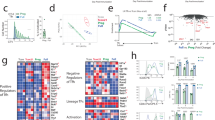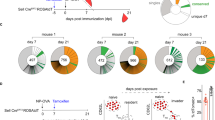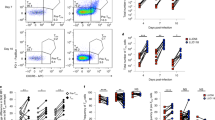Abstract
How follicular helper T cells (TFH cells) differentiate to regulate B cell immunity is critical for effective protein vaccination. Here we define three transcription factor T-bet–expressing antigen-specific effector helper T cell subsets with distinguishable function, migratory properties and developmental programming in vivo. Expression of the transcriptional repressor Blimp-1 distinguished T zone 'lymphoid' effector helper T cells (CD62LhiCCR7hi) from CXCR5lo 'emigrant' effector helper T cells and CXCR5hi 'resident' TFH cells expressing the transcriptional repressor Bcl-6 (CD62LloCCR7lo). We then show by adoptive transfer and intact polyclonal responses that helper T cells with the highest specific binding of peptide–major histocompatibility complex class II and the most restricted T cell antigen receptor junctional diversity 'preferentially' developed into the antigen-specific effector TFH compartment. Our studies demonstrate a central function for differences in the binding strength of the T cell antigen receptor in the antigen-specific mechanisms that 'program' specialized effector TFH function in vivo.
This is a preview of subscription content, access via your institution
Access options
Subscribe to this journal
Receive 12 print issues and online access
$209.00 per year
only $17.42 per issue
Buy this article
- Purchase on Springer Link
- Instant access to full article PDF
Prices may be subject to local taxes which are calculated during checkout







Similar content being viewed by others
Change history
08 March 2009
NOTE: In the version of this article initially published online, CD62L is identified incorrectly as a chemokine. The correct definition should be 'L-selectin'. The error has been corrected for the print, PDF and HTML versions of this article.
References
Fazilleau, N., McHeyzer-Williams, L.J. & McHeyzer-Williams,, M.G. Local development of effector and memory T helper cells. Curr. Opin. Immunol. 19, 259–267 (2007).
McHeyzer-Williams, L.J. & McHeyzer-Williams, M.G. Antigen-specific memory B cell development. Annu. Rev. Immunol. 23, 487–513 (2005).
King, C., Tangye, S.G. & Mackay, C.R. T follicular helper (TFH) cells in normal and dysregulated immune responses. Annu. Rev. Immunol. 26, 741–766 (2008).
Vinuesa, C.G., Tangye, S.G., Moser, B. & Mackay, C.R. Follicular B helper T cells in antibody responses and autoimmunity. Nat. Rev. Immunol. 5, 853–865 (2005).
Breitfeld, D. et al. Follicular B helper T cells express CXC chemokine receptor 5, localize to B cell follicles, and support immunoglobulin production. J. Exp. Med. 192, 1545–1552 (2000).
Kim, C.H. et al. Subspecialization of CXCR5+ T cells: B helper activity is focused in a germinal center-localized subset of CXCR5+ T cells. J. Exp. Med. 193, 1373–1381 (2001).
Ansel, K.M., McHeyzer-Williams, L.J., Ngo, V.N., McHeyzer-Williams, M.G. & Cyster, J.G. In vivo-activated CD4 T cells upregulate CXC chemokine receptor 5 and reprogram their response to lymphoid chemokines. J. Exp. Med. 190, 1123–1134 (1999).
Campbell, D.J., Kim, C.H. & Butcher, E.C. Separable effector T cell populations specialized for B cell help or tissue inflammation. Nat. Immunol. 2, 876–881 (2001).
Quezada, S.A., Jarvinen, L.Z., Lind, E.F. & Noelle, R.J. CD40/CD154 interactions at the interface of tolerance and immunity. Annu. Rev. Immunol. 22, 307–328 (2004).
Mak, T.W. et al. Costimulation through the inducible costimulator ligand is essential for both T helper and B cell functions in T cell–dependent B cell responses. Nat. Immunol. 4, 765–772 (2003).
Vinuesa, C.G. et al. A RING-type ubiquitin ligase family member required to repress follicular helper T cells and autoimmunity. Nature 435, 452–458 (2005).
Snapper, C.M. & Paul, W.E. Interferon-γ and B cell stimulatory factor-1 reciprocally regulate Ig isotype production. Science 236, 944–947 (1987).
Chtanova, T. et al. T follicular helper cells express a distinctive transcriptional profile, reflecting their role as non-Th1/Th2 effector cells that provide help for B cells. J. Immunol. 173, 68–78 (2004).
Fazilleau, N. et al. Lymphoid reservoirs of antigen-specific memory T helper cells. Nat. Immunol. 8, 753–761 (2007).
Nurieva, R.I. et al. Generation of T follicular helper cells is mediated by interleukin-21 but independent of T helper 1, 2, or 17 cell lineages. Immunity 29, 138–149 (2008).
Vogelzang, A. et al. A fundamental role for interleukin-21 in the generation of T follicular helper cells. Immunity 29, 127–137 (2008).
Qi, H., Cannons, J.L., Klauschen, F., Schwartzberg, P.L. & Germain, R.N. SAP-controlled T-B cell interactions underlie germinal center formation. Nature 455, 764–769 (2008).
Gett, A.V., Sallusto, F., Lanzavecchia, A. & Geginat, J. T cell fitness determined by signal strength. Nat. Immunol. 4, 355–360 (2003).
Iezzi, G., Karjalainen, K. & Lanzavecchia, A. The duration of antigenic stimulation determines the fate of naive and effector T cells. Immunity 8, 89–95 (1998).
Fasso, M. et al. T cell receptor (TCR)-mediated repertoire selection and loss of TCR Vb diversity during the initiation of a CD4+ T cell response in vivo. J. Exp. Med. 192, 1719–1730 (2000).
Malherbe, L. et al. Selective activation and expansion of high-affinity CD4+ T cells in resistant mice upon infection with Leishmania major. Immunity 13, 771–782 (2000).
Savage, P.A., Boniface, J.J. & Davis, M.M. A kinetic basis for T cell receptor repertoire selection during an immune response. Immunity 10, 485–492 (1999).
Seder, R.A., Paul, W.E., Davis, M.M. & Fazekas de St Groth, B. The presence of interleukin 4 during in vitro priming determines the lymphokine-producing potential of CD4+ T cells from T cell receptor transgenic mice. J. Exp. Med. 176, 1091–1098 (1992).
Blander, J.M., Sant'Angelo, D.B., Bottomly, K. & Janeway, C.A. Jr. Alteration at a single amino acid residue in the T cell receptor α chain complementarity determining region 2 changes the differentiation of naive CD4 T cells in response to antigen from T helper cell type 1 (Th1) to Th2. J. Exp. Med. 191, 2065–2074 (2000).
Constant, S., Pfeiffer, C., Woodard, A., Pasqualini, T. & Bottomly, K. Extent of T cell receptor ligation can determine the functional differentiation of naive CD4+ T cells. J. Exp. Med. 182, 1591–1596 (1995).
McHeyzer-Williams, L.J., Panus, J.F., Mikszta, J.A. & McHeyzer-Williams, M.G. Evolution of antigen-specific T cell receptors in vivo: preimmune and antigen-driven selection of preferred complementarity-determining region 3 (CDR3) motifs. J. Exp. Med. 189, 1823–1838 (1999).
McHeyzer-Williams, M.G. & Davis, M.M. Antigen-specific development of primary and memory T cells in vivo. Science 268, 106–111 (1995).
Malherbe, L., Hausl, C., Teyton, L. & McHeyzer-Williams, M.G. Clonal selection of helper T cells is determined by an affinity threshold with no further skewing of TCR binding properties. Immunity 21, 669–679 (2004).
Malherbe, L., Mark, L., Fazilleau, N., McHeyzer-Williams, L.J. & McHeyzer-Williams, M.G. Vaccine adjuvants alter TCR-based selection thresholds. Immunity 28, 698–709 (2008).
Panus, J.F., McHeyzer-Williams, L.J. & McHeyzer-Williams, M.G. Antigen-specific T helper cell function: differential cytokine expression in primary and memory responses. J. Exp. Med. 192, 1301–1316 (2000).
Bikah, G., Pogue-Caley, R.R., McHeyzer-Williams, L.J. & McHeyzer-Williams, M.G. Regulating T helper cell immunity through antigen responsiveness and calcium entry. Nat. Immunol. 1, 402–412 (2000).
Mandala, S. et al. Alteration of lymphocyte trafficking by sphingosine-1-phosphate receptor agonists. Science 296, 346–349 (2002).
Wei, S.H. et al. Sphingosine 1-phosphate type 1 receptor agonism inhibits transendothelial migration of medullary T cells to lymphatic sinuses. Nat. Immunol. 6, 1228–1235 (2005).
Haynes, N.M. et al. Role of CXCR5 and CCR7 in follicular Th cell positioning and appearance of a programmed cell death gene-1high germinal center-associated subpopulation. J. Immunol. 179, 5099–5108 (2007).
Obst, R., van Santen, H.M., Mathis, D. & Benoist, C. Antigen persistence is required throughout the expansion phase of a CD4+ T cell response. J. Exp. Med. 201, 1555–1565 (2005).
Celli, S., Garcia, Z. & Bousso, P. CD4 T cells integrate signals delivered during successive DC encounters in vivo. J. Exp. Med. 202, 1271–1278 (2005).
Odegard, J.M. et al. ICOS-dependent extrafollicular helper T cells elicit IgG production via IL-21 in systemic autoimmunity. J. Exp. Med. 205, 2873–2886 (2008).
Sallusto, F., Geginat, J. & Lanzavecchia, A. Central memory and effector memory T cell subsets: function, generation, and maintenance. Annu. Rev. Immunol. 22, 745–763 (2004).
Szabo, S.J., Sullivan, B.M., Peng, S.L. & Glimcher, L.H. Molecular mechanisms regulating Th1 immune responses. Annu. Rev. Immunol. 21, 713–758 (2003).
Bauquet, A.T. et al. The costimulatory molecule ICOS regulates the expression of c-Maf and IL-21 in the development of follicular T helper cells and TH-17 cells. Nat. Immunol. 10, 167–175 (2008).
Shapiro-Shelef, M. et al. Blimp-1 is required for the formation of immunoglobulin secreting plasma cells and pre-plasma memory B cells. Immunity 19, 607–620 (2003).
Turner, C.A. Jr., Mack, D.H. & Davis, M.M. Blimp-1, a novel zinc finger-containing protein that can drive the maturation of B lymphocytes into immunoglobulin-secreting cells. Cell 77, 297–306 (1994).
Martins, G.A. et al. Transcriptional repressor Blimp-1 regulates T cell homeostasis and function. Nat. Immunol. 7, 457–465 (2006).
Martins, G. & Calame, K. Regulation and functions of Blimp-1 in T and B lymphocytes. Annu. Rev. Immunol. 26, 133–169 (2008).
Dent, A.L., Shaffer, A.L., Yu, X., Allman, D. & Staudt, L.M. Control of inflammation, cytokine expression, and germinal center formation by BCL-6. Science 276, 589–592 (1997).
Cimmino, L. et al. Blimp-1 attenuates Th1 differentiation by repression of ifng, tbx21, and bcl6 gene expression. J. Immunol. 181, 2338–2347 (2008).
Williams, M.A., Ravkov, E.V. & Bevan, M.J. Rapid culling of the CD4+ T cell repertoire in the transition from effector to memory. Immunity 28, 533–545 (2008).
Celli, S., Lemaitre, F. & Bousso, P. Real-time manipulation of T cell-dendritic cell interactions in vivo reveals the importance of prolonged contacts for CD4+ T cell activation. Immunity 27, 625–634 (2007).
Henrickson, S.E. et al. T cell sensing of antigen dose governs interactive behavior with dendritic cells and sets a threshold for T cell activation. Nat. Immunol. 9, 282–291 (2008).
Acknowledgements
Supported by the National Institutes of Health (AI047231, AI040215 and AI059475 to M.G.M.-W.). This is manuscript 19762 from The Scripps Research Institute.
Author information
Authors and Affiliations
Contributions
N.F., L.J.M.-W. and M.G.M.-W. designed experiments; N.F. did experiments and analyzed data; N.F., L.J.M.-W. and M.G.M.-W. wrote the manuscript; and H.R. consulted on AAL-R experiments and provided necessary reagents.
Corresponding author
Supplementary information
Supplementary Text and Figures
Supplementary Figures 1–15 and Supplementary Table 1 (PDF 2424 kb)
Rights and permissions
About this article
Cite this article
Fazilleau, N., McHeyzer-Williams, L., Rosen, H. et al. The function of follicular helper T cells is regulated by the strength of T cell antigen receptor binding. Nat Immunol 10, 375–384 (2009). https://doi.org/10.1038/ni.1704
Received:
Accepted:
Published:
Issue Date:
DOI: https://doi.org/10.1038/ni.1704
This article is cited by
-
Same yet different — how lymph node heterogeneity affects immune responses
Nature Reviews Immunology (2023)
-
CD4+ T cell memory
Nature Immunology (2023)
-
T cell receptor and IL-2 signaling strength control memory CD8+ T cell functional fitness via chromatin remodeling
Nature Communications (2022)
-
Niclosamide suppresses the expansion of follicular helper T cells and alleviates disease severity in two murine models of lupus via STAT3
Journal of Translational Medicine (2021)
-
Dynamic CD4+ T cell heterogeneity defines subset-specific suppression and PD-L1-blockade-driven functional restoration in chronic infection
Nature Immunology (2021)



